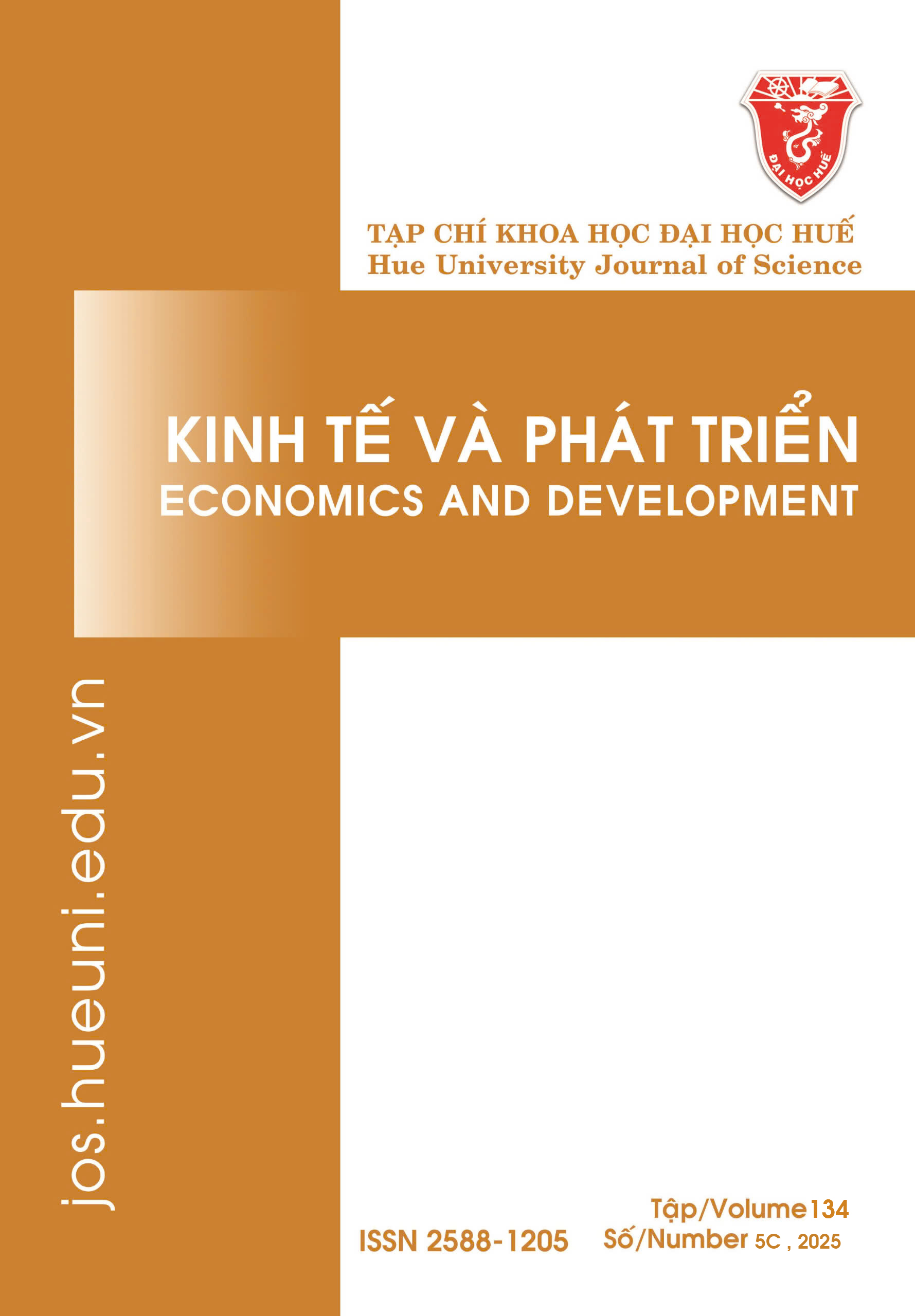Abstract
This study analyzes the factors influencing the purchase frequency of Hue lotus-seed products using a Poisson regression model with survey data from 250 consumers. The results indicate that four factors significantly affect purchase frequency, including positive attitudes toward the product, perceived health benefits, social influence, and difficulties related to purchase location. In addition, demographic characteristics such as age and gender also exert certain effects. The study provides empirical evidence supporting the theory of planned behavior and proposes policy implications to strengthen the brand and expand the market for Hue lotus seeds.
References
- Kotler, P., & Keller, K. L. (2016), Marketing management (15th ed.), Pearson Education.
- Liu, Y. and Gao H. (2018), Traceability management for the food safety along the supply chain collaboration of agricultural products, Agriculture Forestry and Fisheries 7(2): 58.
- Lê Thị Hồng Nghĩa và Nguyễn Tố Như (2020), Các yếu tố ảnh hưởng đến quyết định mua sản phẩm sâm Ngọc Linh của người tiêu dùng tại thị trường Kon Tum, Tạp chí Nghiên cứu Tài chính- Marketing 57 (06/2020), 42–51.
- Nguyễn Văn Thanh Trường và Phan Thị Thanh Hiền (2024), Ảnh hưởng của hoạt động truyền thông marketing qua mạng xã hội đến lòng trung thành thương hiệu và truyền miệng điện tử của người tiêu dùng đối với các thương hiệu cà phê nổi tiếng tại Việt Nam, Tạp chí Khoa học công nghệ trường Đại học Công nghiệp Thành phố Hồ Chí Minh, 70(4).
- Minocha, S., Singh, A., & Banerji, R. (2025), Buying Behavior of Indian Females Toward Natural Personal Care Products: The Moderating Role of Buying Frequency, Jindal Management Journal, 14(1), 116–34.
- Reichheld, F. F., & Schefter, P. (2000), E-Loyalty: Your Secret Weapon on the Web, Harvard Business Review, 78(4), 105–113.
- Lưu Tiến Thuận, Đinh Thị Mỹ Phượng và Nguyễn Thu Nha Trang (2024), Nghiên cứu các nhân tố ảnh hưởng đến ý định mua sản phẩm đạt chứng nhận OCOP của người tiêu dùng trên địa bàn thành phố Cần Thơ, Tạp chí Khoa học Trường Đại học Cần Thơ, 60(2), 45–54, https://doi.org/10.22144/ctu.jvn.2024.060
- Hồ Bội Hoàn (2020), Các nhân tố ảnh hưởng đến việc mua hàng lưu niệm trên thị trường Thành phố Đà Nẵng, Luận văn Thạc sĩ, Đại học Đà Nẵng.
- Nguyễn Thùy Trang (2023), Giải pháp phát triển thị trường cho sản phẩm OCOP: Trường hợp thị hiếu người tiêu dùng đối với trà mãng cầu xiêm, Tạp chí Khoa học Đại học Cần Thơ, 59(3), 247–257.
- Juhl, H. J., Kristensen, K., & Østergaard, P. (2002), Customer satisfaction in European food retailing, Journal of Retailing and Consumer Services, 9(6), 327–334, https://doi.org/10.1016/S0969-6989(02)00013-X.
- Dumortier, J., Evans, K. S., Grebitus, C., & Martin, P. A. (2017), The influence of trust and attitudes on the purchase frequency of organic produce, Journal of International Food & Agribusiness Marketing, 29(1), 46–69. https://doi.org/10.1080/08974438.2016.1255613.
- Anesbury, Z. W., Talbot, D., Day, C. A., Bogomolov, T., & Bogomolova, S. (2020), The fallacy of the heavy buyer: Exploring purchasing frequencies of fresh fruit and vegetable categories, Journal of Retailing and Consumer Services, 53, 101976.
- Nguyễn Văn Chung (2022), Mối liên kết giữa người sản xuất và người thu mua trong hoạt động trồng sen tại huyện Phong Điền, tỉnh Thừa Thiên Huế, Tạp chí Khoa học Đại học Huế: Kinh tế và Phát triển, 131(5A), 145–158. https://doi.org/10.26459/hueuni-jard.v131i5A.6522.
- Engel, J. F., Blackwell, R. D., & Miniard, P. W. (1986), Consumer behavior, Dryden Press.
- Solomon, M. R. (1994), Consumer behavior: Buying, having and being, London: Prenticle Hall.
- Nassè, T. B. (2021), The concept of consumer behavior: definitions in a contemporary marketing perspective, International Journal of Management & Entrepreneurship Research 3(8), 303–307.
- Bourke, B. C., McCarthy, M. B., & McCarthy, S. N. (2024), Behavioural factors influencing consumer acceptance of sustainable healthy food: a review and research agenda, International Journal of Consumer Studies, 48(5), e13078.
- Ajzen, I. (1991), The theory of planned behavior, Organizational Behavior and Human Decision Processes, 50(2), 179–211. https://doi.org/10.1016/0749-5978(91)90020-T.
- Shi ChaoGuang, S. C. and W. K. Wang Kai (2011), Factor analysis of the products' characteristics that influencing the consumers' purchase decision of fresh agricultural products, https://www.cabidigitallibrary.org/action/doSearch?AllField=pb%3A%28%22Zhejiang+Academy+of+Agricultural+Sciences%22%29.
- Govindasamy, R., J. Italia and C. Liptak (1997), Quality of Agricultural Produce: Consumer Preferences and Perceptions, Working paper, Rutgers University, Department of Agricultural, Food and Resource Economics.
- Zhuang, Q. (2018), An Empirical Study on the Influencing Factors of Consumers' Fresh Agricultural Products Purchase Behavior, Proceedings Series, DOI: 10.25236/mse.2018.003.
- Huỳnh Đình Lệ Thu, Nguyễn Thị Minh Thư và Hà Nam Khánh Giao (2021), Các nhân tố ảnh hưởng đến quyết định mua thực phẩm hữu cơ của người tiêu dùng tại thành phố Long Xuyên, Tạp chí Khoa học Đại học Đồng Tháp, 10(1), 71–84.

This work is licensed under a Creative Commons Attribution-ShareAlike 4.0 International License.
Copyright (c) 2025 Array
